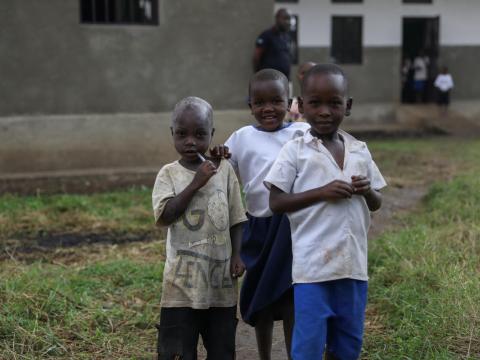DRC: Impact in Binza! What a Year!

1000s of cabbages, 16 clean water wells and 71,703 people, including 41,331 children, whose lives have been impacted.
Despite definite hardships, 2020 had moments of hope and wonder.

Binza in eastern Democratic Republic of Congo is an extremely dangerous place. Currently, no other NGOs are willing to work in the area due to instability and security concerns.
Located between the Ugandan border and the Virunga National Park, it is a place of immense natural beauty - and of bitter and deadly conflict.
In addition to rebel-led armed violence, food insecurity, natural disasters caused by climate change, kidnappings and armed robbery threaten children's lives here, where the rates of malnutrition are alarming.
Binza is a place that can change in an instant. One moment the community could be tending a crop of cabbages when suddenly an armed group can arrive, violently demanding food, stealing community supplies or threatening to kidnap a child to invoke a bribe.

COVID-19, conflict and instability could not stop the incredible impact from being made in Binza. Starting in late 2019, our teams in Binza conducted community workshops to identify the key areas that require immediate support, as well as larger, long-term community sustainable goals.
The community identified, nutrition, food security and water, sanitation and hygiene initiatives as its top priorities.
To begin to address the community’s concerns, 16 additional health staff were hired to monitor the weight of children, helping 2,467 children address and/or recover from the impacts of malnutrition.

Severe malnutrition robs many children, like Glodis, 4, of their lives, or permanently damages their future as ongoing health problems due to inadequate development.
World Vision staff were alerted to Glodis' desperate situation during a community health screening. After several consultations and home visits with Glodis' mother, she agreed to bring him to the health facility for treatment.
Glodis' case was so serious that the child, at the age of 47 months, could not stand up. The first 14 days of treatment were critical, thankfully he survived. Sadly, his younger sibling passed away the previous year as the family was unable to receive help, despite requests at hospitals.
Glodis' mother sadly relays the moment. “Every time I went to the hospital, I was told that we will receive therapeutic milk or [therapeutic food]. But after a few days, we had not received anything. Then one day my youngest child died,” she says.

“Today my child is in good health, I can go to my activities, I don’t need to stay at home anymore. We have survived the stress in our family, now that Glodis is gradually recovering,” his mother thankfully relays.
Glodis is one of thousands of children who have survived severe malnutrition and are on their way to recovering and building a future.
World Vision not only seeks to meet the immediate needs of children like Glodis, but to help the community build sustainable initiatives that address the root causes of poverty.